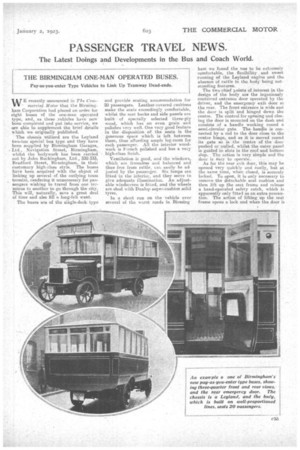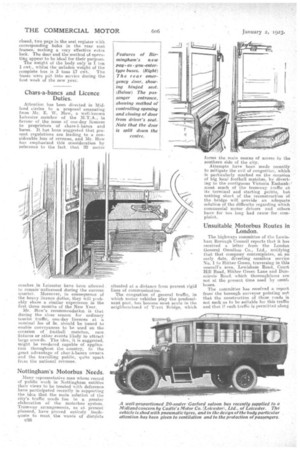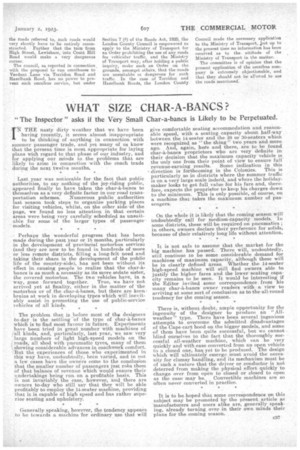PASSENGER TRAVEL NEWS.
Page 21

Page 22

Page 23

If you've noticed an error in this article please click here to report it so we can fix it.
The Latest Doings and Developments in the Bus and Coach World.
THE BIRMINGHAM ONE-MAN OPERATED BUSES.
Pay-as-you-enter Type Vehicles to Link Up Tramway Dead-ends.
E recently announced in Tbe Clil O W mercial Motor that the Birthingham Corporation had placed an order for eight buses of the one-man operated type, and, as these yehicles have now been completed and putinto service, we Are able to supplement the brief details which we originally published.
The chassis utilized are the Leyland two-ton special bus type and they have been supplied by Birmingham Garages, Ltd., Navigation Street, Birmingham, whilst the bodywork has been carried out by John Buckingham, Ltd., 332-333, Bradford Street, Birmingham, in their customary high-class style. The buses have been acquired with the object of linking up several of the outlying tram termini, rendering it unnecessary for passengers wishing to travel from one terminus to another to go through the city. This will, naturally, save a great deal of time and also fill a long-felt want.
The buses are of the single-deck type and provide seating accommodation for 20 passengers. Leather-covered cushions make the seats exceedingly comfortable, whilst the seat backs and side panels are built of specially selected three-ply wood, which has an even grain and polishes very well. One very good feature in the disposition of the seats is the generous space which is left between them, thus affording ample leg-room for each passenger. All the interior woodwork is French polished and has a very high-class finish.
Ventilation is good, and the windows, which are frameless and balanced and thus free from rattle, can easily be ad. justed by the passenger. Six lamps are fitted in the interior, and they serve to give adequate illumination. An adjustable windscreen is fitted, and the wheels are shod with Dunlop super-cushion solid tyres.
in a short run on the vehicle over several of the worst roads in Birming ham we found the bus to be extremely comfortable, the flexibility and sweet running of the Leyland engine and the absence of rattle in the body being outstanding features.
The two chief points of interest in the design of the body are the ingeniously contrived entrance door operated by the driver, and the emergency exit door at the rear. The front entrance is wide and the door is split and hinged down the centre. The control for opening and closing the door is mounted on the dash and consists of a handle working round a semi-circular gate. The handle is connected by a rod to the door close to. the centre hinge, and as it is moved round its gate so is the centre of the door pushed or pulled, whilst the outer panel is guided in slots in the roof and bottom step. The action is very simple' and the door is easy to operate.
As for the rear exit door, this may be opened very quickly and easily, but at the same time, when closed, is securely locked. To open, it is only necessary to remove the detachable seat cushion and then lift up the seat frame and release a hand-operated safety catch, which is apparently only fitted as an extra precaution. The action of lifting up the seat frame opens a lock and when the door is
closed, two pegs in the seat register with corresponding holes in the rear scat frames; making a very effective extra lock. The door and the method of operating appear to be ideal for their purpose.
The weight of the body only is 1 ton 1 cwt., whilst the unladen weight of the complete bus is 3 tons 17 cwt. The buses were put into service during the first week of the new year.
Chars-a-bancs and Licence Duties.
Attention has been directed in Midland circles to a proposal emanating fitorn Mr. E. W. How, a well-known Leicester member of the M.T.A., in favour of Oro issue of one-day licences to proprietors of chars-a•bancs and buses. It has been suggested that present regulations are leading to a considerable loss of revenue, and Mr. How has emphasized this consideration by reference to the fact that 20 motor coaches in Leicester have been allowed to remain unlicensed during the current quarte'r. Moreover, in consequence of the heavy licence duties, they will probably sham a similar experience in the first three months of the New Year, Mr. How's recommendation is that during the close season for ordinary tourist traffic, one-day licences at a nominal fee of 5s. should be issued to enable conveyances to be used on the occasion of football matches, race fixtures or other events likely to attract large crowds. The idea, it is suggested, might be rendered capable of application throughout the country, to the great advantage of char-a.-bancs owners and the travelling public, quiteapart from the national revenue.
Nottingham's Motorbus Needs.
Many representative men whose record of public work in Nottingham entitles their views to be treated with deference have participated recently in supporting the idea that the main solution of the city's traffic needs lies in a greater elaboration of the motorbus system.. Tramway arrangements, as at present planned, have proved entirely inadequate to meet the wants of districts
C36 situated at a distance from present rigid lines of communication.
The congestion of general traffic, in which motor vehicles play the predominant part, has become most acute in the neighbourhood of Trent Bridge, which forms the main means of access to the southern side of the city.
Attempts have been made recently to mitigate the evil of congestion, which is particularly marked on the occasion of big local football matches, by diverting to the contiguous Victoria Embank' meat much of the tramway traffic at its terminal and starting points, but nothing shortof the reconstruction of the bridge will provide an adequate solution of the difficulty regarding which commercial motor drivers and others have for too long had cause for corn
Unsuitable Motorbus Routes in London.
The highways committee of the Lewisham Borough Councilreports that it has received a letter from the Landon General Omnibus Co., Ltd., notifying that, that company contemplates, at an early date, diverting omnibus service No. 1 to Hither Green, traversing in this council's area, Lewisham Road, Court Hill Road, Hither Green Lane and Duncrievie Road. which thoroughfares are not at the present time used by omnibuses.
The committee has received a report from the borough surveyor pointing out that the construction of these roads is not such as to be suitable for this traffic and that if such traffic is permitted along the roads referred to, Such roads would very shortly have to be entirely reconstructed. Further that the turn from High Street, Lewisham, into Court Hill Road would make a very dangerous corner.
The council, as reported in connection. with the proposal to run omnibuses to Verdant Lane via Torridon Road and Hazelbank Road, has no power to prevent such omnibus service, but under Section 7 (4) of the Roads Act, 1920, the London County Council is empowered to apply to the Ministry of Transport for an Order prohibiting the use of any roads for vehicular traffic, and the Ministry of Transport may, after holding a public inquiry, make such an Order on the grounds, amongst others, that the roads are unsuitable or dangerous for such traffic. In the case of Torridon and Hazelbank Roads, the London County Council made the necessary application to the Ministry of Transport, lout up to the present time no information has been received as to the attitude of the Ministry of Transport in the matter.
The committee is of opinion that the present application of the omnibus company is extremely objectionable, and that they should not be al.1.>wed to use the roads mentioned.






























